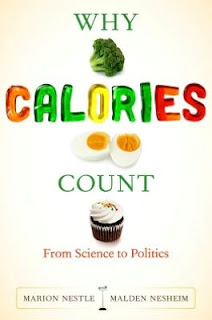 Emeritus of Nutritional Sciences at Cornell University. He is coauthor (with Marion Nestle) of Feed Your Pet Right: The Authoritative Guide to Feeding Your Dog and Cat and (with Ann L. Yaktine) of the Institute of Medicine report Seafood Choices: Balancing Benefits and Risks.
Emeritus of Nutritional Sciences at Cornell University. He is coauthor (with Marion Nestle) of Feed Your Pet Right: The Authoritative Guide to Feeding Your Dog and Cat and (with Ann L. Yaktine) of the Institute of Medicine report Seafood Choices: Balancing Benefits and Risks.Nestle applied the "Page 99 Test" to their new book, Why Calories Count: From Science to Politics, and reported the following:
Why Calories Count is about everything my co-author, Malden Nesheim, and I could think of that is related to calories: how they were discovered, how you measure them in food and in the body, how many you need and why, what happens when you have too few, and what happens when you have too many. We also included the way calories are used in society: diets and dieting, labeling, and how the entire food system is set up to encourage people to eat more calories, not fewer.Learn more about the book at Marion Nestle's website.
Calories in food come from the digestion and metabolism of only four components: proteins, fats, carbohydrates—and alcohol. Most books about nutrition, diets, and health forget about alcohol, but that’s a mistake. As the USDA scientist Wilbur Atwater meticulously measured in the late 1800s, the metabolism of alcohol yields 7 calories per gram or 100 calories per standard size drink. Alcohol provides more calories than either protein or carbohydrate, and almost as many as fat. That’s what the science tells us.
Politics explains why alcohol calories are such a well kept secret. They rarely appear on the labels of alcoholic beverages because they do not have to. Alcohol labels are not regulated by the FDA and do not display Nutrition Facts. For reasons of history—remember Prohibition?—alcoholic beverages are regulated by the Treasury Department, which gets more revenue if people drink more.
Page 99 comes in the middle of a short chapter on the secret calories in alcohol and what you have to do to figure out how many your drinks might contain.
Page 99:If you drink light beer, the labels do the calorie-counting work for you. The label of Pennsylvania’s Yuengling Light Lager, for instance, gives an average analysis: 99 calories, 8.5 grams carbohydrates, 0.82 grams protein, and 0.1 grams fat. Forget about the protein and fat. Their calories are negligible. As with any “light” beer, a standard serving provides about 100 calories. But how much alcohol does it contain? You can figure this out by subtracting the minimal calories from protein, fat, and carbohydrate and working backward with the formula, but why bother? This is a light beer, and its percent alcohol will be closer to 4 percent than to 10 percent.
Nutrition advocacy groups have complained for years about the confusing and uninformative labeling of alcohol beverages and have pressed for a more rational system for displaying the content of alcohol, calories, and ingredients. But their efforts to date have not succeeded, as we explain in chapter 24.
Do Alcohol Calories Count?
Yes, they do. But if anything about alcohol calories can still be considered perplexing, it is surely the way they are metabolized in the body. Alcohol is not changed by digestion. It is absorbed into the body intact, where it goes straight to the liver. There enzymes convert it to acetaldehyde, a potentially toxic substance thought to be responsible for much of the damage to the liver, heart, and other organs seen so frequently in “heavy drinkers” who habitually drink too much alcohol.
Unlike the way other energy-producing molecules in food are used in the body, how alcohol is metabolized depends greatly on the amount consumed. People who drink small amounts of alcoholic beverages readily metabolize acetaldehyde to acetate. Acetate enters normal energy-yielding metabolic pathways and ends up excreted as carbon dioxide and water or, if calories are in excess, stored as body fat. Large amounts of alcohol, however, increase the deposition of fat in the liver and overcome the body’s ability to metabolize acetaldehyde. This substance accumulates and causes damage, especially to the liver and the heart. People vary greatly in the rates at which they metabolize alcohol, which is why it affects different people in such different ways.
These differences may explain why alcohol calories do not affect everyone’s body weight in the same way. People who drink large amounts of alcohol are not necessarily more obese than nondrinkers and often display relatively lower body weights.
The Page 99 Test: Marion Nestle's Pet Food Politics.
--Marshal Zeringue



